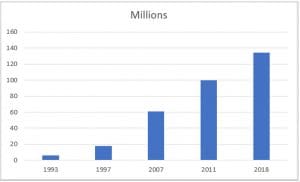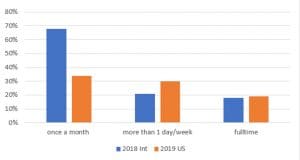What works – the research
How the pandemic changed things
Where to from here?
People have been working remotely for decades. Suddenly there is huge interest in remote working as a result of the pandemic.
In this article we take a deep dive into the historical data to see how prevalent remote working has been. We look at the kind of roles that most frequently work remotely, and how much time they spend doing that.
We look at survey data of the benefits and the challenges experienced by remote workers and their employers.
In particular we look at whether working remotely affects productivity, including the impact of the work environment, tools and resources.
For all these factors we look at the impact of the pandemic and the likely effect on the future of remote work.
Remote working before the pandemic
Evolution and Prevalence
An exponential increase
In 1993, there were an estimated 5.89 million teleworkers in the United States1. Between 1993 and 1997, this number grew by over 200% to 18 million2. A decade later there were an estimated 61 million remote workers. The numbers had grown over 200%.3 Approximately 87% of employers made telework arrangements available to their employees in 2008.
The number of mobile workers globally was anticipated to surpass one billion in 2011, representing more than 30% of the global workforce4.
In 2018 an Owl Labs survey5 of more than 3000 workers across 23 countries found 39% worked remotely 1 day a week. This would extrapolate to 1.34 billion workers in 2018, based on IMF global workforce estimates of 3.427 billion.

However, Gallup international surveys report findings that employees working some of the time remotely rose from 39% in 2012 to 43% in 20166.
There is some variation by country, as you would expect. On a percentage basis just less than one third of the Australia workforce worked from home regularly in 201510.
Impact of the pandemic
With the onset of the COVID 19 pandemic virtually everyone had to work from home during lock down periods – if they could.
The Wrike 20207 survey found a significant number of workers felt uncomfortable about working from home. 43% of professionals felt they were less effective than working out of their office.
Nearly half of workers (49%) say they had never worked from home prior to the outbreak of COVID-19. An additional 23% say they previously only worked from home during special circumstances, such as caring for sick kids or during extreme weather events.
As so many full-time employees are being forced to work remotely due to COVID-19, the results point to a disruptive experience for this group of employees new to working from home.
Another survey of 800 U.S. workers at enterprise companies with 1,500+ full time employees and three or more office locations was run by Smartsheet in April 2020. Responses indicate 82% of enterprise workers feel less productive at work since going remote. Over 90% of young workers reported having difficulty working remotely.8

The pandemic was unexpected. So, it is not a surprise that over half of respondents reported they did not have the infrastructure or tools in place to effectively work remotely.
Those that did have the tools were unlikely to have had training. For many, expectations of what they were to accomplish were unclear and standard procedures were not in place. 8
Despite advances in technology for virtual collaboration, most organisations are still using the traditional tools; email, Instant Messaging, phone and texts. 8
In the Owl labs June/July 2020 survey of over 2000 US workers it was found that almost 70% were working remotely due to Covid. Of these 77% would be happy to continue. Almost 50% said they would not return to a job that did not allow flexi work. 81% believe their employer will support remote work after Covid. 9
Intensity - time spent working remotely
Gallup6 found that it is not just the percentage of employees working remotely that is increasing. Many are spending a greater percentage of their working time working remotely.
In 2012, 24% of remote working employees spent 80% or more of their time working remotely. In 2016 that had increased to 31%.
The number working remotely 40% to 80% of the time had increased only slightly. The number working remotely less than 20% of the time decreased. The percentage of employees who work remotely 100% of the time had risen from 15% to 20%. These numbers are generally confirmed by other surveys.

In 2018 more than one-third (34%) of U.S. full-time employees did most of their work from a remote location. This according to an ORC International 2018 survey10, a slight increase since 2013.
Almost all respondents (98%) report some form of work flexibility. This is regardless of their workplace location.
Overall, the survey found 68% of respondent workers in 38 countries worked remotely at least once a month. 21% of them more than one day a week, but only 18% worked remotely full time.
Owl surveyed 1202 full time US workers in 2019. 62% did some remote work. 38% worked only in place. The 62% of survey respondents who work remotely do so at different frequencies. 54% work remotely at least once per month. 48% at least once per week, and 30% full-time11.
Post pandemic 92% of Owl Lab 2020 respondents expect to work remotely at least 1 day per week, and 80% at least 3 days per week.9

